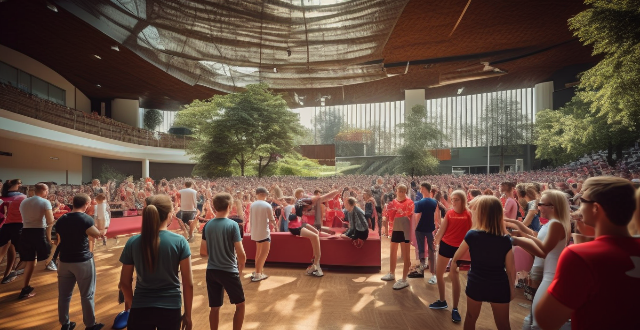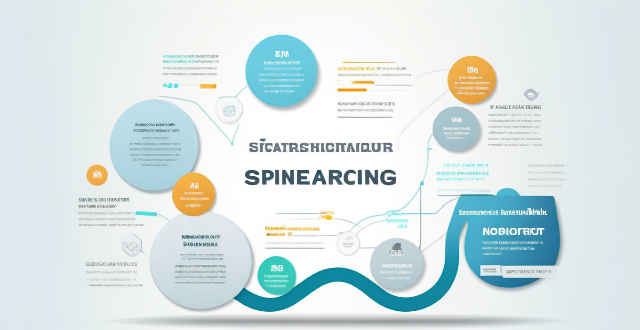Charity Sports

Can you suggest ways to combine sports and charity work effectively ?
Combining sports and charity work is an effective way to make a positive impact on society while also promoting physical activity and healthy living. By organizing charity sporting events, partnering with charities to support their mission through sports, and using sports as a platform for awareness and education about important issues, we can create a powerful force for good that benefits people in need while also fostering a sense of community and teamwork within the sports world.

What are the tax benefits of donating to a sports charity event ?
Donating to a sports charity event can provide several tax benefits, including tax deductions, charitable contribution limits, carryover benefits, and qualified charitable distributions. Cash and non-cash donations can both be deducted from taxes, with the amount of the deduction depending on the donation's value and the type of charity event. The IRS limits charitable contributions based on income level and charity type, but excess amounts can be carried over to future years. Qualified charitable distributions (QCDs) allow individuals age 70½ or older to make tax-free donations directly from their IRA to a sports charity event, satisfying required minimum distributions without incurring taxes.

What role do sponsors play in sports charity events, and how do they benefit from it ?
The role of sponsors in sports charity events is crucial for the success of these events. Sponsors provide financial support, enhance brand awareness, promote corporate social responsibility, and create networking opportunities. In return, they benefit from increased exposure and brand recognition, building relationships with key stakeholders, potential tax benefits, and measurable results. Overall, sponsoring sports charity events allows companies to contribute to a worthy cause while positioning themselves as responsible corporate citizens committed to making a positive impact on society.

How can I organize a sports event to benefit a charity organization ?
Organizing a sports event to benefit a charity organization involves several key steps, from planning and preparation to post-event follow-up. Here's a detailed outline of how to go about it: ### Planning and Preparation 1. **Choose the Right Sport:** Select a sport that will attract participants and spectators likely to support your chosen charity. Ensure the sport is accessible to people of all ages and skill levels. 2. **Set Clear Objectives:** Define how the event will benefit the charity and set fundraising goals. 3. **Select an Appropriate Venue:** Find a venue that can accommodate the expected number of participants and spectators, ensuring it has adequate facilities like restrooms and parking. ### Promotion and Marketing 1. **Create a Marketing Plan:** Outline how you will promote the event to maximize participation and awareness for the charity. Use multiple channels such as social media, local advertising, and word-of-mouth. 2. **Partner with Local Businesses:** Seek sponsorships from local businesses in exchange for promotion during the event. Offer sponsors perks like logo placement or exclusive advertising rights. 3. **Leverage Social Media:** Create dedicated social media pages for the event to keep participants and supporters updated. Engage with your online community by sharing updates, answering questions, and encouraging participation. ### Registration and Participation 1. **Simplify the Registration Process:** Offer easy online registration using platforms like Eventbrite or Active.com. Provide clear information about the event, including dates, times, fees, and registration deadlines. 2. **Offer Incentives for Participation:** Introduce rewards or recognition programs for participants who meet certain fundraising milestones. Publicly acknowledge top contributors through awards or special mentions. ### Event Day Logistics 1. **Coordinate Volunteers:** Gather a group of volunteers to help with tasks like setup, registration, and cleanup. Assign roles to ensure smooth operation on the day of the event. 2. **Manage Facilities and Supplies:** Make sure all necessary sports equipment is available and properly maintained. Arrange refreshments like water, snacks, and possibly post-event meals for participants and volunteers. 3. **Maintain Safety Standards:** Have first aid kits available and establish emergency protocols. Consider hiring medical staff or security personnel depending on the size and nature of the event. ### Post-Event Follow-Up 1. **Thank Participants and Sponsors:** Show appreciation through thank-you notes or emails to everyone involved. Share success stories publicly to highlight the impact of the event on the charity and its beneficiaries. 2. **Evaluate the Event's Success:** Solicit opinions from participants, volunteers, and sponsors to understand what worked well and what could be improved. Analyze financial results to see if fundraising goals were met and identify areas for future growth. By following these steps, you can successfully organize a sports event that not only engages the community but also makes a significant contribution to your chosen charity organization.

How can fans get involved in their favorite celebrity's charity work ?
Fan involvement in a favorite celebrity's charity work can take many forms, from direct donations to volunteering time and skills, spreading awareness, participating in challenges, collaborative projects, and staying updated on the charity's activities. These actions not only support the causes championed by celebrities but also foster a deeper connection between fans and the stars they admire.

What are some examples of successful sports charity events ?
Successful sports charity events like the Nike Foundation's "Girl Effect" Marathon, The Komen Race for the Cure, and The Wounded Warrior Project's Carry Forward 5K have raised millions of dollars for various causes by combining the excitement of sports with philanthropy. These events engage participants in physical activity, raise funds and awareness for important causes, and create a sense of community among participants and supporters.

How can sports events be used to raise funds for charity ?
**Raising Funds for Charity through Sports Events: A Guide to Integrating Fundraising into Sports Events** **Introduction: The Power of Sports in Fundraising** - Sports events are a powerful tool for raising funds and awareness for charitable causes. **Strategies for Integrating Fundraising into Sports Events** 1. **Ticket Sales and Donations:** Charge admission fees and place donation boxes at event entrances and exits. 2. **Corporate Sponsorships:** Partner with local businesses and create sponsor challenges within the event. 3. **Merchandise Sales:** Sell branded merchandise and auction off unique items during the event. 4. **Peer-to-Peer Fundraising:** Encourage participants to raise money through their personal networks and leverage online platforms. **Implementation Steps for Successful Fundraising** 1. **Clear Objectives and Communication:** Set clear goals and keep donors informed about how their contributions will be used. 2. **Event Promotion and Marketing:** Utilize social media, engage with local media outlets, and promote the event and its charitable cause. 3. **Streamlined Operations:** Simplify the registration process and ensure transparent financial management. **Conclusion: The Lasting Impact of Sports Fundraising** - Use the event as a springboard for ongoing fundraising efforts and share stories of how the funds raised have made a difference.

How do celebrities balance their public image with their charity work ?
Celebrities navigating the challenge of maintaining a positive public image while engaging in charity work can adopt several strategies: 1. **Authenticity**: Genuine care for supported causes resonates with the public and fans. 2. **Transparency**: Open communication about charitable activities builds trust and avoids overpromising. 3. **Alignment with Personal Brand**: Selecting causes that align with their personal brand maintains consistency in their public image. 4. **Engage with Fans**: Interacting with fans about charity work fosters community and encourages involvement. 5. **Consistency**: Regular involvement shows long-term commitment rather than fleeting interest. 6. **Avoid Controversy**: Stay away from polarizing issues to prevent backlash on public image and charity. 7. **Collaborate with Other Celebrities**: Joint efforts amplify reach and show unity among peers. 8. **Measure Impact**: Showcasing tangible results demonstrates the effectiveness of their charitable efforts. 9. **Seek Professional Advice**: Consulting experts helps navigate complexities in balancing public image and charity work. By following these strategies, celebrities can balance public image with charity work, ensuring benefits for both their supported causes and their reputation.

How do sports figures use their influence to promote charitable causes ?
Athletes and sports figures leverage their fame, influence, and reach to promote charitable causes, making a difference in various aspects of humanitarian work. They use their platform to educate the public about issues that need attention, share personal stories related to the cause, organize matches or events where proceeds go towards a specific charity, donate prize money from competitions, create special merchandise with a portion of sales going to support a charity, volunteer time with organizations, give back to local communities by participating in local events or contributing to community projects, meet with legislators to discuss policies that could positively impact their supported causes, engage in lobbying efforts, partner with established charitable organizations, and team up for endorsement deals that include clauses where a portion of earnings goes towards a specific charity or is used to support a social initiative.

How do sports events promote social interaction and community building ?
Sports events play a significant role in promoting social interaction and community building. They bring people together, foster a sense of belonging, and create opportunities for individuals to connect with one another. This is achieved through encouraging participation, building community spirit, providing entertainment and recreation, facilitating networking opportunities, and enhancing diversity and inclusion. By bringing people together around a shared passion for sports, these events create lasting connections and positive experiences that extend far beyond the playing field.

Which celebrities are known for their charity work ?
The text discusses the charity work of various celebrities, including Angelina Jolie, Oprah Winfrey, George Clooney, Taylor Swift, Ellen DeGeneres, and Shonda Rhimes. These individuals have used their platforms to support various causes such as refugee crises, education, healthcare, animal conservation, and domestic violence intervention. Their contributions have made a positive impact on society and raised awareness about important issues.

What impact do sports-related charitable activities have on local communities ?
Sports-related charitable activities have a significant impact on local communities by promoting physical fitness, enhancing civic pride, providing educational opportunities, fostering diversity and inclusion, and addressing social issues. These activities bring people together, teach valuable life skills, and promote healthy lifestyles among children and young adults. By getting involved in sports-related charitable activities, we can make a positive difference in our local communities and create a brighter future for all.

How do different types of sports sponsorship (e.g. title sponsorship, kit sponsorship) affect a company's brand exposure ?
This text discusses various types of sports sponsorship, including title sponsorship, kit sponsorship, venue sponsorship, event sponsorship, and team sponsorship. Each type offers different impacts on brand exposure, such as high visibility, brand association, targeted audience reach, community involvement, and potential for success sharing. Overall, sports sponsorship provides companies with opportunities to align themselves with the excitement and passion of sports, reaching diverse audiences and enhancing their brand image.

Can celebrity involvement in charity work have a negative impact ?
Celebrity involvement in charity work can bring attention and funds to organizations but may also have negative consequences such as overshadowing the cause, misalignment of values, dependency on celebrity influence, manipulation of emotions, and impact on other charities. It is important for both celebrities and charities to ensure their partnership is authentic, transparent, and aligned with the mission and values of the organization to minimize any adverse effects and maximize positive outcomes.

What are the benefits and drawbacks of celebrity endorsements for charity organizations ?
Celebrity endorsements can significantly impact charity organizations by increasing visibility, accessing wider audiences, and generating financial contributions. However, drawbacks include the potential for negative perceptions, high costs, and a lack of long-term sustainability.

How can I get involved with women-focused charity work locally or internationally ?
Involving in women-focused charity work is a meaningful way to promote gender equality and empower women. This guide provides tips on how to get involved locally and internationally, including researching organizations, volunteering time, donating money or resources, attending events and fundraisers, fundraising for international organizations, participating in online campaigns, and traveling abroad to support women's issues. Additionally, it emphasizes the importance of being open-minded, building relationships, staying informed, and evaluating your impact to make the most of your participation.

What is the most effective way for celebrities to use their platform for charity ?
Celebrities can use their platform for charity by choosing a cause they resonate with, raising awareness, collaborating with other influencers, participating in fundraising events, using their talents and skills, and advocating for policy changes.

How do sports and religious beliefs intersect ?
The intersection of sports and religious beliefs is multifaceted, touching upon aspects of culture, morality, community, and ethics. Sports events often begin with prayers or invocations, seeking divine guidance or protection. Athletes may engage in private prayer or meditation before games to calm their nerves and focus their minds. Some athletes attribute their success to their faith and openly share their religious beliefs during interviews or on social media. Religious teachings often emphasize honesty and integrity, which translate to advocating against doping and cheating in sports. In cases of disputes or conflicts within sports teams, religious beliefs can guide approaches to reconciliation and forgiveness. Whether it's through rituals, values, personal expressions of faith, community building, or ethical considerations, sports offer a unique platform for religious beliefs to be lived out loud.

How can fans participate in or support charitable initiatives through their favorite sports teams or athletes ?
Sports fans can support charitable causes by participating in or donating to initiatives of their favorite teams and athletes, volunteering for projects, purchasing merchandise, spreading awareness on social media, joining fan clubs, and following the lead of athletes and teams.

How do you create an effective sports marketing strategy ?
Creating an effective sports marketing strategy requires a deep understanding of the target audience, the sports industry, and the brand's goals. Here are some steps to follow: 1. Identify the Target Audience: Research demographics, interests, and behaviors of potential customers. 2. Define the Brand's Goals: Set specific, measurable, achievable, relevant, and time-bound (SMART) goals. 3. Conduct Market Research: Analyze competitors, trends, and consumer preferences, and identify opportunities for partnerships or sponsorships. 4. Develop a Unique Selling Proposition (USP): Highlight the brand's strengths and benefits that resonate with the target audience. 5. Create a Marketing Mix: Tailor advertising, public relations, promotions, and sponsorships to the target audience and align with the brand's goals. 6. Measure and Evaluate Results: Track key performance indicators (KPIs) such as website traffic, social media engagement, and sales revenue to identify areas for improvement and inform future marketing strategies.

What are some recent celebrity charity events ?
Recent Celebrity Charity Events 1. The Global Citizen Live Event, hosted by Hugh Jackman and Deborra-lee Furness, aimed to end extreme poverty by 2030 through performances by various artists and calls to action from activists. 2. Hand in Hand: A Benefit For Hurricane Relief, organized in response to hurricanes Harvey, Irma, and Maria, raised over $44 million for relief efforts through a star-studded concert featuring Oprah Winfrey, Beyoncé, George Strait, and more. 3. One Love Manchester, held by Ariana Grande after a terrorist attack at her concert, raised funds for the victims' families and showcased the resilience and solidarity of Manchester through performances by Miley Cyrus, Pharrell Williams, Katy Perry, and others.

How do you create a sports marketing campaign that resonates with your target audience ?
Creating a sports marketing campaign that resonates with your target audience requires understanding their interests, preferences, and behaviors. Define your target audience by demographics, psychographics, and behavioral factors. Conduct market research through surveys, focus groups, and competitive analysis. Develop messaging that highlights benefits, values, and emotional appeal. Choose channels such as social media, email marketing, and events that align with your target audience's interests. Measure your results by tracking KPIs, A/B testing, and adjusting and optimizing over time.

What is the role of sports in enhancing urban social cohesion ?
Sports play a significant role in enhancing urban social cohesion by promoting community engagement, fostering a sense of belonging, and providing opportunities for individuals to come together and share common experiences. Sports events and activities provide a platform for residents to gather, interact, and participate in their local community, leading to increased social interaction, as well as a greater sense of ownership and pride in one's neighborhood. Sports teams and clubs can create a strong sense of identity and loyalty among their members, which extends beyond the playing field and into everyday life. Finally, sports provide numerous opportunities for individuals to come together and share common experiences, helping bridge divides between different groups within urban communities.

How does sports culture influence society's perception of health and fitness ?
Sports culture significantly influences societal perceptions of health and fitness by promoting physical activity, raising health awareness, fostering mental well-being, challenging stereotypes, and driving economic growth in the health and fitness industry. This multifaceted impact enhances individual lives and contributes to the overall well-being of communities and nations worldwide.

What are some innovative ways to promote my sports facility and attract more visitors ?
Promoting a sports facility requires a combination of traditional marketing techniques and innovative strategies to stand out in a crowded market. Here are some ways you can promote your sports facility and attract more visitors: 1. Host Events and Tournaments 2. Partner with Local Schools and Clubs 3. Social Media Marketing 4. Community Outreach Programs 5. Referral Programs and Membership Incentives 6. Collaborate with Local Businesses 7. Enhance Your Online Presence

What are the best practices for managing a sports facility ?
Managing a sports facility involves strategic planning, effective communication, and attention to detail. Best practices include setting clear objectives, developing a business plan, maintaining cleanliness and safety, equipment maintenance, training staff, offering quality services, building brand awareness, attracting new customers, budget allocation, and revenue generation. By following these best practices, you can create a successful and thriving sports facility that meets the needs of your customers and achieves your business objectives.

What are some of the most successful celebrity-led charity organizations ?
There are several successful celebrity-led charity organizations that have made a significant impact on society. Here are some of them: 1. The Elton John AIDS Foundation is a non-profit organization founded by Sir Elton John in 1992 to raise awareness and fund research for HIV/AIDS prevention, treatment, and education. 2. The Robin Hood Foundation is a New York City-based non-profit organization founded by billionaire businessman Paul Tudor Jones II in 1988. 3. The Ryan Seacrest Foundation is a nationally recognized nonprofit organization founded by television personality Ryan Seacrest in 2010. 4. The Leonardo DiCaprio Foundation is an environmental conservation organization founded by actor Leonardo DiCaprio in 1998. 5. The George Clooney Foundation for Justice is a human rights organization founded by actor George Clooney in 2016.

What are the benefits of sponsoring a sports event for a business ?
Sponsoring a sports event can boost brand visibility, target specific audiences, and enhance corporate image. It also provides opportunities for community engagement, CSR initiatives, experiential marketing, and personalized interactions with customers. By sponsoring a sports event, businesses can increase customer loyalty and establish themselves as reputable brands within their industries.

How does sports sponsorship influence the marketing strategies of competing brands in the same industry ?
Sports sponsorship has a significant impact on marketing strategies by increasing brand awareness, differentiation from competitors, creating emotional connections with consumers, and improving public relations. Examples include Coca-Cola's sponsorship of the FIFA World Cup, Nike's partnership with Michael Jordan, Gatorade's sponsorship of Serena Williams, and Adidas' participation in Run for Peace. These benefits help brands stand out in crowded markets and are likely to continue driving investments in sports sponsorship as part of overall marketing strategies.

What impact does sports have on the social cohesion and community spirit in rural areas ?
The article discusses the impact of sports on social cohesion and community spirit in rural areas. Sports bring people together, promote teamwork, and create a sense of belonging that can strengthen the fabric of a community. The article explores how sports build social capital by forming friendships and encouraging civic engagement. It also highlights how sports promote teamwork and cooperation by teaching communication skills and collaboration towards a common goal. Finally, the article emphasizes how sports create a sense of belonging within a community by supporting local teams and participating in community events. Overall, sports have a significant impact on rural communities and contribute to their overall well-being.